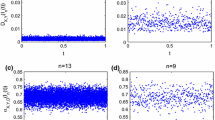Abstract
In this paper we employ actual wireless data that draw from well known archives of network traffic traces and investigate the scaling and multifractal properties of WLAN traffic by using a multifractal detrended fluctuation analysis technique. Through multifractal analysis, the scaling exponents, generalized Hurst exponents and singularity spectrum are derived. These results indicate that the WLAN traffic is multifractal. Moreover, comparing the generalized Hurst exponent of the original WLAN traffic series with the result of the corresponding shuffled series, we conclude that the multifractality nature of WLAN traffic is due to both fat-tailed probability distributions and long range correlations.
Similar content being viewed by others
References
IEEE. (1999). IEEE Std 802.11b-WLAN Medium Access Control (MAC) and Physical layer (PHY) Specifications: High Speed Physical Layer (PHY) in the 2.4 GHZ Band.
Koukoutsidis, Y., & Siris, V. A. (2007). Modeling Approximations for an IEEE 802.11 WLAN Under Poisson MAC-Level Arrivals. In Proceedings of IFIP Networking, Atlanta, USA, pp. 439–449.
Laddomada M., Mesiti F., Mondin M., Daneshgaran F. (2010) On the throughput performance of multirate IEEE 802.11 networks with variable-loaded stations: analysis, modeling, and a novel proportional fairness criterion. IEEE Transactions on Wireless Communications 9(5): 1594–1607
Prakash G., Thangaraj P. (2011) Non-saturation throughput analysis of IEEE 802.11 distributed coordination function. European Journal of Scientific Research 51(2): 157–167
Foh C. H., Zukerman M., Tantra J. W. (2007) A markovian framework for performance evaluation of IEEE 802.11. IEEE Transactions on Wireless Communications 6(4): 1276–1285
Leland W., Taqqu M., Willinger W., Wilson D. V. (1995) Self-similarity in high-speed packet traffic: analysis and modeling of Ethernet traffic measurements. Statistical Science 10: 67–85
Karagiannis, T., Molle, M., Faloutsos, M. et al. (2004). A nonstationary Poisson view of internet traffic. In Proceedings of IEEE Conference on Computer Communications, Hong Kong, pp. 1558–1569.
Ribeiro V., Zhang Z.L., Moon S. et al (2005) Small-time scaling behaviors of internet backbone traffic. Computer Networks 48: 315–334
Masugi M. (2009) Applying a recurrence plot scheme to analyze non-stationary transition patterns of IP-network traffic. Communications in Nonlinear Science and Numerical Simulation 14(4): 1418–1430
Takuma T., Masugi M. (2009) A hierarchical clustering scheme approach to assessment of IP-network traffic using detrended fluctuation analysis. Communications in Nonlinear Science and Numerical Simulation 14(4): 697–707
Balachandran, A., Voelker, G. M., Bahl, P., et al. (2002). Characterizing user behavior and network performance in a public WLAN. In Proceedings of ACM SIGMETRICS Conference on Measurement and Modeling of Computer Systems, ACM Press, Marina. del Rey, CA, USA, pp. 195–205.
Schwab, D., & Bunt, R. (2004). Characterizing the use of a campus wireless network. In Proceedings of IEEE Conference on Computer Communications, Hong Kong, pp. 862–870.
Henderson, T., Kotz, D., & Abyzov, I. (2004). The changing usage of a mature campus wide wireless network. In Proceedings of ACM/IEEE International Conference on Mobile Computing and Networking, Philadelphia, pp. 187–201.
Kotz D., Essien K. (2005) Analysis of a campus-wide wireless network. Wireless Networks 11(1–2): 115–133
Rodrig, M., Reis, C., Ahajan, R. M, Wetherall, D., & Zahorjan, J. (2005). Measurement-based characterization of 802.11 in a hotspot setting. In Proceedings of 2005 ACM SIGCOMM workshop on Experimental approaches to wireless network design and analysis, New York, NY, USA, pp. 5–10.
Meng, X., Wong, S., Yuan, Y., et al. (2004). Characterizing flows in large wireless data networks. In Proceedings of ACM/IEEE International Conference on Mobile Computing and Networking, Philadelphia, USA, pp. 174–186.
Hernandez-Campos, F., Karaliopoulos, M., Papadopouli, M., & Shen, H. (2006). Spatio-temporal modeling of traffic workload in a campus WLAN. In Proceedings of Second Annual International Wireless Internet Conference, Boston, MA, USA, 2006.
Karaliopoulos, M., Papadopouli, M., Raftopoulos, E., & Shen, H. (2007). On scalable measurement-driven modeling of traffic demand in large WLANs. In Proceedings of 15th IEEE Workshop on Local and Metropolitan Area Networks, pp. 102–110.
Feng, H., Shu, Y., & Yu, L. (2007). An empirical analysis of aggregate WLAN traffic characteristic. In Proceedings of SPIE Next-Generation Communication and Sensor Networks, 6773, pp. 1–8.
Fei H., Yu B. (2008) A multiscale analysis and modeling of wireless traffic. International Symposium on Information Science and Engieering 2: 209–212
Xiang L., Ge X.H., Zhang K., Liu C. (2009) A self-similarity frame traffic model based on the frame components in 802.11 Networks. International Conference on Computational Science and Engineering 2: 955–960
Kantelhardt J.W., Zschiegner S.A., Koscielny-Bunde E. et al (2002) Multifractal detrended fluctuation analysis of non-stationary time series. Physica A, 316(1–4): 87–114
Sadegh Movahed, M., Jafari, G. R., Ghasemi, F., Rahvar, S., & Reza Rahimi Tabar, M. (2006). Multifractal detrended fluctuation analysis of sunspot time series. Journal of Statistical Mechanics: Theory and Experiment, P02003.
Kantelhardt J. W., Koscielny-Bunde E., Rego H. H. A., Havlin S., Bunde A. (2001) Detecting long-range correlations with detrended fluctuation analysis. Physica A 295: 441–454
Feder J. (1988) Fractals. Plenum Press, New York
Peitgen H. O., Jurgens H., Saupe D. (1992) Chaos and fractals. Springer, New York
Tang, D., & Baker, M. (2000). Analysis of a local-area wireless network. In Proceedings of MOBICOM’00, Boston, USA. pp. 1–10.
Oswiecimka P., Kwapien J., Drozdz S., Rak R. (2005) Investigating multifractality of stock market fluctuations using wavelet and detrending fluctuation methods. Acta Physica Polonica B 36(8): 2447–2457
Matsuda, T., & Yamamoto, M. (2004). Performance evaluation of multi-fractal nature of TCP traffic with RED gateway. In Proceedings of 29th Annual IEEE International Conference on Local Computer Networks, USA, pp. 400–401.
Author information
Authors and Affiliations
Corresponding author
Rights and permissions
About this article
Cite this article
Feng, H., Xu, Y. Multifractal Detrended Fluctuation Analysis of WLAN Traffic. Wireless Pers Commun 66, 385–395 (2012). https://doi.org/10.1007/s11277-011-0347-y
Published:
Issue Date:
DOI: https://doi.org/10.1007/s11277-011-0347-y



